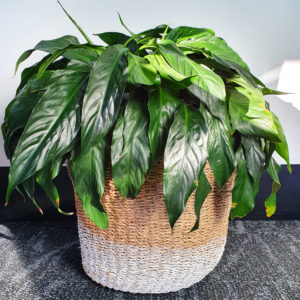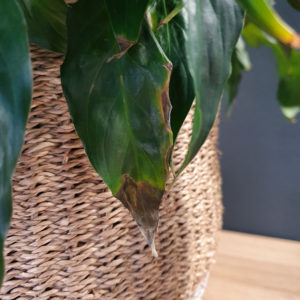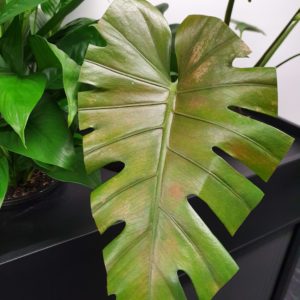What's wrong with your indoor plant?
You've given it love, light and water, but your once-gorgeous indoor plant is now looking like a sulky, sad question mark in the corner. What to do? We take a look at some of the common signs of a suffering indoor plant, and how you can nurse it back to health.
Factors that impact the health of your indoor plant
While there'll always be trial and error involved when figuring out your plant's needs, the number one best way to keep your indoor green friends healthy and free of pests and disease, is to ensure you choose the right plant for the right location. Don't try to force your favourite plant to work in unsuitable conditions. Instead, check the plant label, or ask our expert staff in-store for suitable plants for your space.
Ultimately, if positioned in a spot that's not too dark, not too light, and you water and feed it as required, your indoor plant should fight to stay gorgeous and healthy. However, sometimes problems crop up, and if you spot them early, you can make a few adjustments to keep your greens happy and healthy.
Common problems and causes
 Entire plant has wilted
Entire plant has wilted
This will happen if the plant is thirsty. To avoid over-watering, it can be suitable for many indoor plants to let them wilt slightly before giving them a deep drink. If the plant has been watered regularly, you may have overdone it and the plant could be suffering root rot. Otherwise, over-fertilising and exposure to cold temperatures can also cause wilting.
New growth wilted or burned
A range of potential problems here, including excess fertiliser (leaching will be needed to save your plant), cold draughts, hot draughts, too dry, too warm, sunburn or freeze damage. Again, if your plant is in the correct position, consider your air conditioning or heating or whether you could be over-fertilising.
Rapid defoliation
A rapid loss of leaves could be the result of over-watering/under-watering, exposure to draughts, or even abrupt changes in temperature or light - for example, moving the plant from a bright position to low light.
Failure to flower
Insufficient water or exposure to light is most common, however over-fertilising can also be a cause, so make sure you're not compensating by over-feeding.
 Spotted foliage
Spotted foliage
Possible causes include over-watering (check roots for signs of rot), burn from direct sun, cold water on foliage, fungal infection (especially if plants are in humid and/or wet conditions) or pollutants in the air.
Silver or red blotches on foliage
Your plant is getting too much direct sun.
Gradual defoliation (lower leaves yellow and falling off)
This could be an indication of root damage due to over-watering, or alternatively, not enough water to support full foliage. It could also be due to lack of light or fertiliser.
Flower buds drop before opening
Dropping flower buds will be caused by temperature fluctuations, draughts or lack of humidity. Consider whether air conditioning or heating is a contributing factor, and if the air is dry, try filling a saucer with pebbles and water and sitting it beneath your indoor pot, or spritzing the plant occasionally with a water sprayer.
 Browning of leaf tips or edges
Browning of leaf tips or edges
Browning of leaves can be caused by lack of humidity, using the wrong fertiliser or using too much, poor water quality (high chlorine, fluoride, sodium, boron, soluble salts levels), incorrect soil pH, spray damage from insecticides, oil or leaf-glossing materials or even environmental pollutants in the air.
Foliage pale and weak
This can be due to insufficient light conditions, or perhaps conditions are too dry for the plant (either soil or air). Another potential factor is lack of nutrients, meaning it needs fertilising.
Stunted plants
Stunted plants are a result of root damage by either excess fertiliser or too little or too much water.
New foliage is small, pale and spindly
The plant is not getting the light, water or nutrition it needs. Ensure it's positioned where it receives enough light, and check its fertiliser needs.
 Leaves yellowed between veins (veins remain green)
Leaves yellowed between veins (veins remain green)
This indicates a nutrient deficiency. If the potting medium's pH is too high it is deficient in iron, or an acidic/low pH indicates a magnesium deficiency.
Leaves drop continuously, new leaves on tips are small and curled
Possible causes are unburned gases in air, spray or vapour damage from cleaning fluids, industrial pollution or general pollutants in the atmosphere, or possible aphid or mite damage.
Tiny white spots on leaves
This is usually caused by spider mites, which can be treated with Eco Oil.
Fuzzy grey mould that covers flowers, leaves and stems
This could likely be Botrytis blight, which is a fungal disease generally caused by dead leaves and spent flowers being left on the plant, too much humidity or poor ventilation.
Want more information on identifying and treating pests on your indoor plants? This article should be your first stop!

